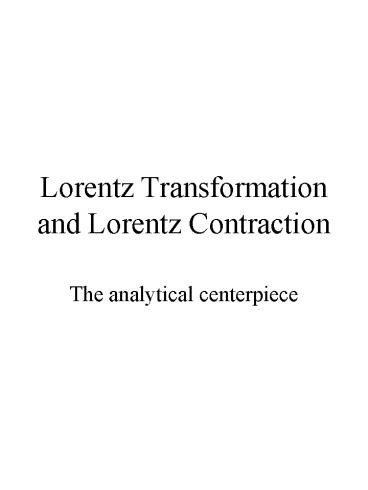Lorentz Transformation and Lorentz Contraction - PowerPoint PPT Presentation
1 / 15
Title:
Lorentz Transformation and Lorentz Contraction
Description:
Permit me now to draw your attention to the ether. ... equations of hydrodynamics, and in which therefore there may be various turbulent motions? ... – PowerPoint PPT presentation
Number of Views:252
Avg rating:3.0/5.0
Title: Lorentz Transformation and Lorentz Contraction
1
Lorentz Transformation and Lorentz Contraction
- The analytical centerpiece
2
Hendrik Lorentz
- Nobel Prize, 1902
- 1902 lt 1905!
3
From Noble lecture 1902
Permit me now to draw your attention to the
ether. Since we learnt to consider this as the
transmitter not only of optical but also of
electromagnetic phenomena, the problem of its
nature became more pressing than ever. Must we
imagine the ether as an elastic medium of very
low density, composed of atoms which are very
small compared with ordinary ones? Is it perhaps
an incompressible, frictionless fluid, which
moves in accordance with the equations of
hydrodynamics, and in which therefore there may
be various turbulent motions? Or must we think of
it as a kind of jelly, half liquid, half solid?
4
Clearly, we should be nearer the answers to these
questions if it were possible to experiment on
the ether in the same way as on liquid or gaseous
matter. If we could enclose a certain quantity of
this medium in a vessel and compress it by the
action of a piston, or let it flow into another
vessel, we should already have achieved a great
deal. That would mean displacing the ether by
means of a body set in motion. Unfortunately, all
the experiments undertaken on these lines have
been unsuccessful the ether always slips through
our fingers.
5
Having reached this point, we can consider the
ether as a substance of a completely distinctive
nature, completely different from all ponderable
matter. With regard to its inner constitution, in
the present state of our knowledge it is very
difficult for us to give an adequate picture of
it.
6
Lorentz transformation
7
Review
- Spacetime interval
- Invariant by definition
- Definition?
- Time read by inertial clock present at both
events - Invariant speed of light implies
8
(No Transcript)
9
Euclidean space
10
Minkowski space
11
Minkowski
Euclidean
12
Euclidean
Minkowski
Physics implies geometry
13
Hyperbolic geometry
Euclidean geometry
14
Time dilation?
15
Length contraction































